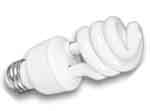Difference Between CFL and LED
 CFL vs. LED
CFL vs. LED
LEDs, or Light Emitting Diodes, have been in public use a lot longer than Compact Fluorescent Lamps, or CFLs. These are the tiny diodes that light up to indicate that something is on, or blink to attract attention. CFLs are just modified versions of the common fluorescent lamp, to achieve lower energy costs, and to fit with the slot type of the common incandescent bulb. Initially, these two light sources were used for different applications, as LEDs did not produce enough illumination for a decent light source, while CFLs were too big and too fragile to be used as indicators. However, in recent years, developments in LED technology make it a viable light source.
As stated previously, LEDs are substantially smaller, making it ideal for applications that require a very small light source; but due to its small size, the illumination that it can provide is far less compared to a CFL. To counteract this, it is common practice to use multiple LED bulbs, grouped together with the use of reflectors to focus the beam.
Another key feature of LEDs that make it superior compared to CFLs, is its energy needs. LEDs consume much less power compared to a CFL. This is why LEDs are preferred in portable devices where the power supply is limited. High efficiency means that less power is wasted, and converted to heat. Heating problems, and the fragility of CFL bulbs, make it unsuitable for applications where there is human contact. LEDs are able to work without the need for extra components, like the ballast. This is because LEDs are able to function at very low voltages, and can even work with alternating current (AC) and direct current (DC).
In LCD screens, you can find two types of backlighting, LED and Cold CFL. For this application, LEDs prove to be superior, as each LED behind the LCD screen can be turned on and off independently. Turning the LEDs off, allow the LCD display to create a much darker black than can be achieved in a CFL LCD, where the bulbs cannot be turned off.
Summary:
1. CFL is the smaller version of the fluorescent bulbs that are common in most homes and offices, while LEDs are common in electronic devices.
2. LEDs are substantially smaller compared to CFL.
3. You need a lot more LEDs to match the light of a single CFL.
4. LEDs are more energy efficient compared to CFLs.
5. LEDs do not need extra components, like the ballasts that CFLs need.
- Difference Between Sony Cybershot S Series and W Series - December 22, 2012
- Difference Between Samsung Galaxy S3 and iPhone 5 - December 21, 2012
- Difference Between Samsung Galaxy S2 (Galaxy S II) and Galaxy S 4G - December 20, 2012

Hi,
LED’s do required a driver/ballast to condition the power supplied to it. Else under unregulated power the LED’s will die down before their promised life time.
Amazing article, I like your website, and Please update it even more often.
There have been a lot of changes since you wrote your article. Can you update it please?
Sir,,,what is basic difference b/w led and cfl in case of efficiency .